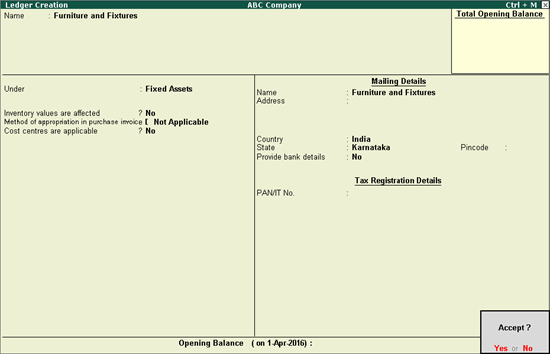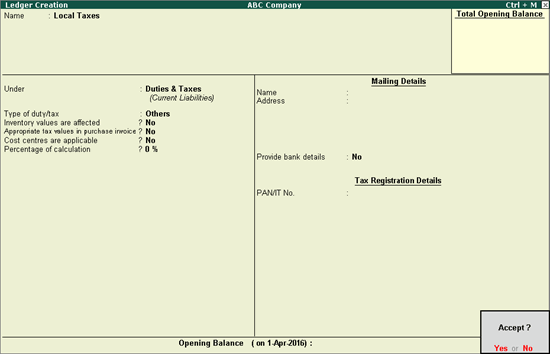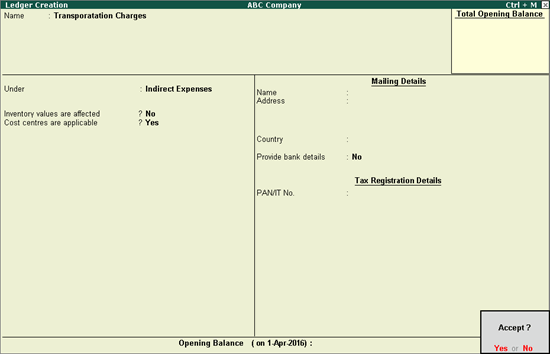
A ledger is the actual account head to identify your transactions and are used in all accounting vouchers. For example, purchase, payments, sales, receipts, and others accounts heads are ledger accounts. Without a ledger, you cannot record any transaction.
On this page
Display, Alter and Delete Ledgers
Button options in Ledger master
Current Liabilities and Current Assets Ledgers
Enter Mailing Details for Ledger Accounts
All ledgers have to be classified into groups . These groups and ledgers are classified into profit and loss or balance sheet.
There are two pre-defined ledgers in Tally.ERP 9:
● Cash ledger
● Profit and loss account
|
Cash Ledger |
Profit and Loss Ledger |
|
The cash ledger is grouped under cash-in-hand. |
The profit and loss account ledger is grouped under primary. |
|
You can enter the opening balance as on the day the books begin. |
The previous year's profit or loss is entered as opening balance of the ledger. The balance entered is the opening profit/loss. It is shown in the balance sheet as opening of the profit and loss account in the liabilities. |
|
This ledger can be altered and deleted. |
This ledger can not be deleted but it can be modified. |
1. Go to Gateway of Tally > Accounts Info. > Ledgers > Create (Single Ledger) . The Ledger Creation screen appears as shown below:

2. Enter the Name of the ledger account. Duplicate names are not allowed.
3. Enter the alias of the ledger account, if required. You can access the ledgers using the original name or the alias name.
4. Select a group category from the List of Groups.
Note: To create a new group from this field, press Alt+C .
You can alter a ledger account to change its group classification at any time. See Importance of Grouping and Accounting Classifications for more details.
5. Enter the Opening Balance. The opening balance is applicable when the ledger is an asset or a liability, and also if it has a balance in the account as on the date of beginning of books.
Note: For an existing company,debit balances for assets and credit balances for liabilities are applicable. You can enter balances for accounts that have obverse balances such as revenue accounts. For example, you may have transferred your books to Tally.ERP 9 in the middle of the year and may not have closed them in your earlier system. Hence, you must specify debit or credit for the balance.
You can alter any information of the ledger master with the except for the closing balance under the group s tock-in-hand .
Display/alter a ledger
● Go to Gateway of Tally > Accounts Info. > Ledgers > Display or Alter .
Modification of account ledgers is possible for single ledgers as well as multiple ledgers. However for multiple ledgers, all the fields are not available for alteration.
Delete a ledger
● Go to Gateway of Tally > Accounts Info. > Ledgers > Alter > Press Alt+D .
Note: You can delete the ledger if no vouchers have been created under it. If you want to delete a ledger for which vouchers have been created, you have to first delete all the vouchers from that ledger and then delete the ledger account.
|
Buttons |
Keys |
Description and Usage |
|
G: Groups |
Ctrl+G |
Click to create account Group from the Ledger creation screen. |
|
E: Currency |
Ctrl+C |
Click to create Currency from the Ledger creation screen. |
|
S: Cost Category |
Ctrl+S |
Click to create Cost Category from the Ledger creation screen. |
|
C: Cost Centre |
Ctrl+C |
Click to create Cost Center from the Ledger creation screen. |
|
B: Budget |
Ctrl+B |
Click to create Budget from the Ledger creation screen. |
|
V: Voucher Types |
Ctrl+V |
Click to create Voucher Type from the Ledger creation screen. |
Accounts like Outstanding Liabilities, Statutory Liabilities and other minor liabilities can be created directly under Current Liabilities and Assets can be classified as Current assets and Fixed assets. To create Fixed Assets ledger:
1. Go to Gateway of Tally > Accounts Info. > Ledgers > Create .

2. Enable Inventory values are affected option if you maintain accounts with inventory. However, you can use this option for accounts like Customs Duty, direct expenses related to purchases such as Freight Inwards and so on.
3. Enable Cost Centres are applicable to allocate transactions to a particular Cost Center. You have to set the option Maintain cost centres to Yes in F11: Accounting Features , to get this option in the Ledger creation screen.
Note: Set the option Activate interest calculation to Yes to calculation of interest automatically based on the interest rate and style of calculation specified for this ledger account. Set the option Use advanced parameters to Yes to use advanced parameters when interest rates change from time to time.
Tax Ledgers should be created under Duties and Taxes group which contains all tax accounts like VAT, CENVAT, Excise, Sales and other trade taxes and total liability.
1. Go to Gateway of Tally > Accounts Info. > Ledgers > Create .

2. The option Type of Duty/Tax is based on statutory compliance of the company. For Indian statutory, by default, Others is displayed. Depending on features in F11: Statutory & Taxation , more options can be included in the Type of Duty/Tax.
3. Enable Inventory values affected option if you maintain accounts with inventory. However, you can use this option for accounts like Customs Duty, direct expenses related to purchases such as Freight Inwards and so on.
4. Enable Cost Centres are applicable to allocate transactions to a particular Cost Center. You have to set the option Maintain cost centres to Yes in F11: Accounting Features , to get this option in the Ledger creation screen.
Note: In F11: Accounting features, set the option Activate interest calculation to Yes to calculation of interest automatically based on the interest rate and style of calculation specified for this ledger account. Set the option Use advanced parameters to Yes to use advanced parameters when interest rates change from time to time.
5. Select the Percentage of Calculation the rate of tax e.g. 5%, 10%, 12.5% etc. You can use an automatic discount calculation facility by specifying a negative percentage in this field. The Group Duties and Taxes is used for automatic tax calculation.
6. On entering a percentage, a new field Method of Calculation is displayed. From the Method of Calculation , select appropriate options to calculate the Tax/Duty.
This is used to round off the duty value. By default rounding method is set blank. Once you select rounding method, rounding limit option is displayed.
For example:
For duty value 123.33 and rounding Limit is 1,
● Downward rounding will show as 123.
● Normal rounding will show as 123.
● Upward rounding will show as 124.
For Duty value 125.55 and rounding Limit is 1,
● Downward rounding will show as 125.
● Normal rounding will show as 126.
● Upward rounding will show as 126.
You can select the income or expenses account group to create ledgers.
1. Go to Gateway of Tally > Accounts Info. > Ledgers > Create .
2. Enter the name of the ledger in the Name field.
3. Select Indirect Expenses from the List of Groups in the Under field.
Note: Select Indirect Income from the List of Groups if you want to create an income ledger.
4. Set the option Inventory values are affected? to Yes if your company maintains a ccounts with inventory .

5. Press Ctrl+A to accept.
You can also enable cost centre options in expenses or income ledger. to enable Cost Centres in the Ledger Creation screen
1. Go to Gateway of Tally > F11: Features > Accounting Features > set the option Maintain cost centres to Yes .
2. In the ledger master, set the option Cost centres are applicable to Yes , if the transactions have to be allocated to a particular cost centre.
You can create multiple Ledgers at a time in this mode. This will save the time of the user.
1. Go to Gateway of Tally > Accounts Info. > Ledgers > Multiple ledgers > Create .
2. S elect All Items or the required group under which you want to create the ledger. If you select All Items, you can select the group for each ledger in the Under column.
3. Enter the Name of Ledger .
4. Enter the Opening Balance . This is the balance as on the date of beginning of books. If you have opted to maintain balances bill-by-bill, you must give the bill details.
5. Specify whether the Opening Balance is Debit or Credit in the field Dr/Cr .

6. Save the Multi Ledger Creation screen.
Note: While creating Ledgers in multiple mode, the field Cost Centres are applicable, is set to Yes for Revenue accounts and No for Non-Revenue accounts by default. The field Inventory values are affected is set to Yes for Sales and Purchase Accounts and No for the others by default.
You can record address details against ledger accounts in Tally.ERP 9.
1. Go to Gateway of Tally > Masters > Account Info. > Ledgers > Create .
2. Press F12: Configure to view the Ledger Configuration screen.
3. Set the option Use addresses for ledger accounts? to Yes . The Ledger Configuration screen appears as shown below:

4. Press Ctrl+A to accept.
Now you can enter the mailing details during ledger creation or alteration.
Note: To add mailing details for revenue accounts, set the option Use addresses for revenue accounts? to Yes .